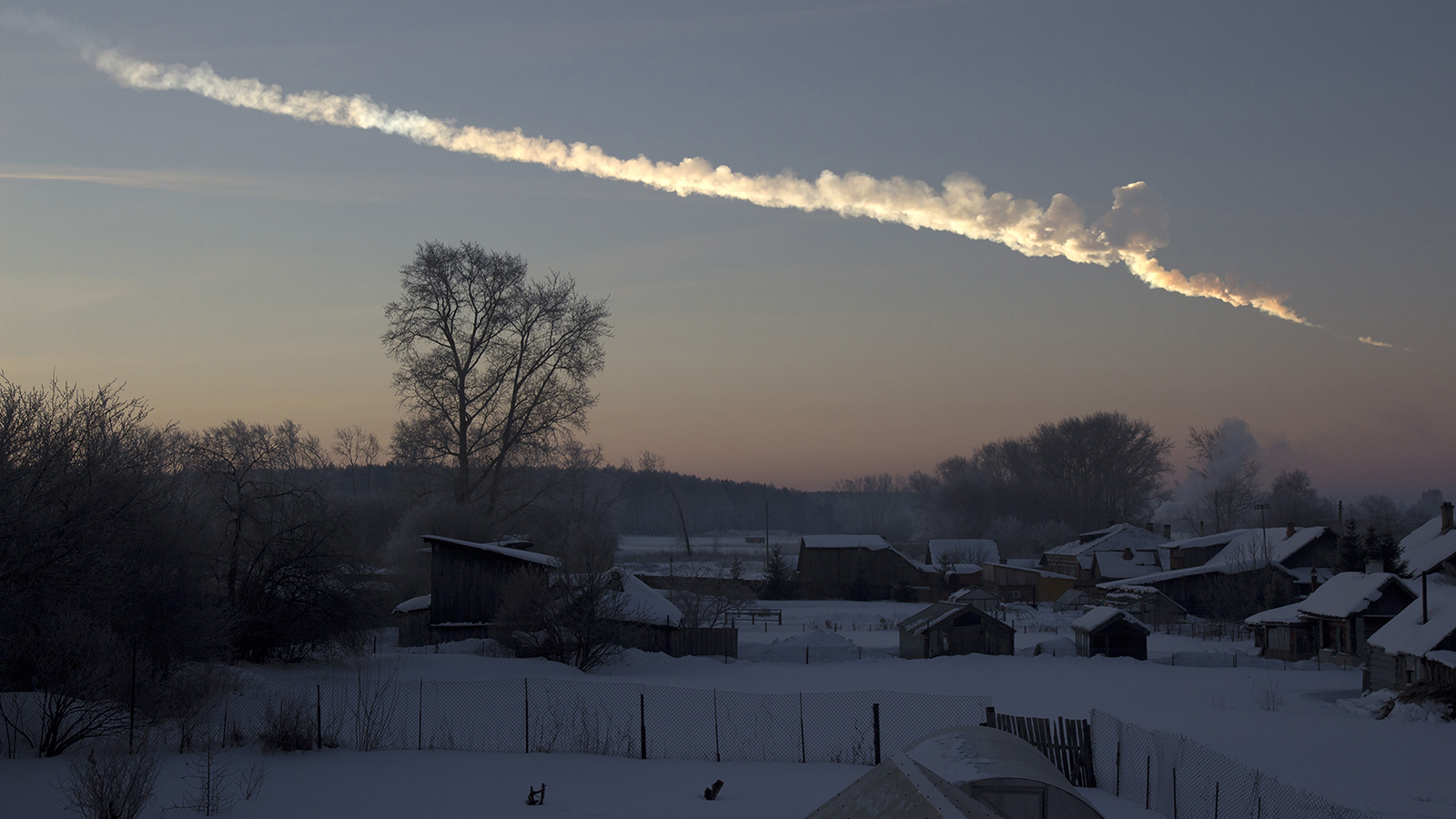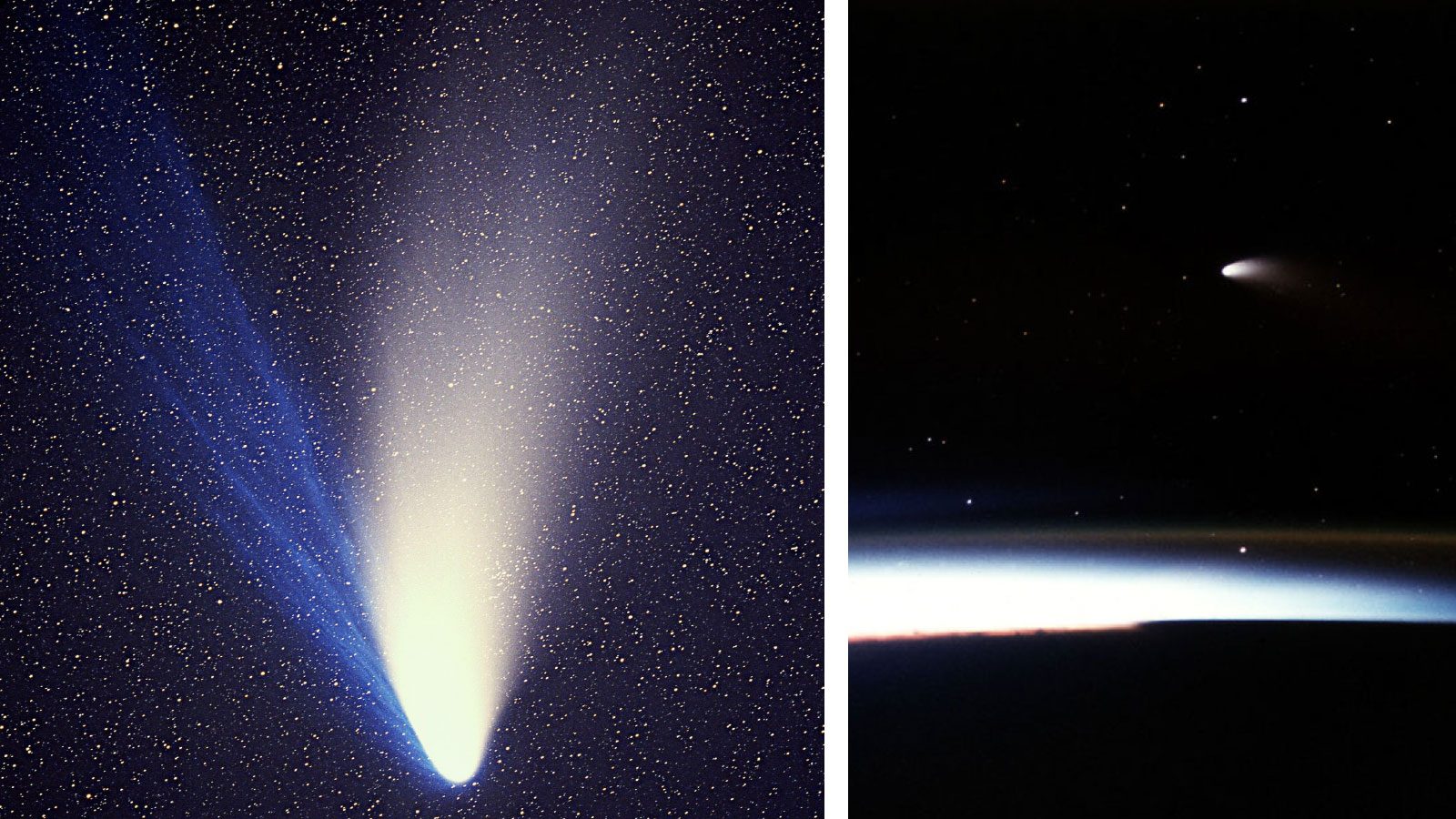The comet conundrum
By Jon Kelvey|February 2023
Hollywood loves its comets, but many of those in the planetary defense field are more focused on the threat of an asteroid strike, given the long odds of a comet smashing into Earth. Who is right? Here’s what Jon Kelvey found out.
Astronomers who specialize in spotting dangerous objects headed our way are not above conjuring their own scenarios like those in the 2021 dark comedy “Don’t Look Up.”
Here’s one of them: It’s April 4, 2024, and astronomers looking through a ground-based optical survey telescope have just discovered a new comet, its icy nucleus steaming in the sunlight to produce a characteristic tail as it passes inside the orbit of Saturn. The roughly 1-kilometer-wide dirty snowball will cross Earth’s orbit in just 22 months. Astronomers cannot be certain yet, but the odds are much higher than anyone is comfortable with that the comet could crash into us in late February 2026.
If you were in charge of NASA’s Planetary Defense Coordination Office, as Lindley Johnson is, you could take some comfort in the success of a mission conducted two years earlier with a different class of objects. The agency’s Double Asteroid Redirection Test, or DART, mission showed that a kinetic impactor could nudge an asteroid and alter its orbit.
“This demonstrates we are no longer powerless to prevent this type of natural disaster,” Johnson said in a statement following DART’s impact on the asteroid moonlet Dimorphos. Combined with a comprehensive catalog of all the hazardous asteroids, “a DART successor could provide what we need to save the day.”
But DART targeted an asteroid, and comets are not asteroids. Comets falling into our solar system are more difficult to detect, their paths are tougher to predict because they off gas sublimating volatiles like water and carbon dioxide ice, and they’re harder to deflect because, on average, they are much larger. Discover a potentially hazardous asteroid, and you can predict its potential close passes with Earth for years or decades, but comets don’t often work that way.
All of which is to say that when it comes to comets, “two years’ warning is really, really short unless you’ve prepared a lot on the ground,” says Paul Chodas, director of the Center for Near Earth Object Studies at the NASA-funded Jet Propulsion Laboratory in California. He designed the above scenario, with different dates, for the fourth annual Planetary Defense Conference in 2019 to get people thinking about the threat from comets. Because even though the odds of a comet strike are astronomically low — in fact, much lower than an asteroid strike — “the consequences would be devastation, global devastation, for even a relatively small, long-period comet.”
Johnson tells me that the efforts his office continues to make to detect hazardous asteroids will inevitably help discover more comets. Other groups at NASA have contemplated comet interceptor spacecraft, while some researchers in California even envision directed energy tools, giant lasers, to help redirect comets in dangerous orbits.
The ideas range from potentially feasible to fantastic in terms of their practicality, which may be exactly where the thinking needs to be at the moment. DART was an impossible dream for the whole history of life on Earth until less than a year ago, and with millions of years expected between significant comet strikes, there’s potentially plenty of time — so long as you don’t wait till the last minute.
Comets are different
In the original script for “Don’t Look Up,” director Adam McKay used a 100-kilometer-wide asteroid, knocked mysteriously off course, to drive his climate change allegory, an exploration of society dealing with an impending global disaster. But wanting a degree of realism rather than pure deus ex machina, McKay consulted with Chodas and his center about this massive plot device.
“I read the early version of his script, and I indicated that what he had proposed was so far-fetched that he should consider something else,” Chodas says. “If he wanted to consider a plausible major impact event with global effects, extinction level, if you will, that what was plausible was a long-period comet impact.”
Long-period comets are different from Jupiter-family comets, which typically traverse their elliptic orbits in 20 years or less. Long-period comets can take thousands or tens of thousands of years to orbit the sun, such that the few that fall into the solar system each year may never have been seen before. Falling in from the icy Oort Cloud anywhere from 10,000 to 100,000 astronomical units out from the sun, they are almost invisible until they get close enough to the sun to begin thawing and leaving trails of dust and gas — the comet coma — somewhere between the orbits of Saturn and Jupiter.
That doesn’t leave long between sighting and warning, about the 22 months that Chodas built into his scenario. To take a real-world example, Comet Siding Spring (C/2013 A1) was discovered on Jan. 3, 2013, inside the distance of Saturn’s orbit, about 7 AU, and made a close pass of Mars on Oct. 19, 2014.
“It took them about six months to figure out that it wasn’t going to actually hit Mars,” says Joseph Nuth, a chemist at NASA’s Goddard Space Flight Center in Maryland and member of the OSIRIS-REx* asteroid sample return mission science team, as well as a member of a Goddard group studying hazardous impact threats. “Out of those 22 months, basically, six are already gone to try to figure out whether or not it’s going to hit Earth.”
That’s already bad enough, but long-period comets also “have weird orbits with respect to Earth’s orbit,” says Derek Richardson, a University of Maryland professor of astronomy and DART team member. While asteroids tend to orbit in the plane of the ecliptic — the plane of Earth’s orbit around the sun — long-period comets can come from any direction, which means the relative speed between the comet and Earth is higher, he says, “and of course, the energy of the impact is proportional to the mass, but to the square of the relative speed.”
Long-period comets typically travel at around 65 kilometers per second in the inner solar system, so in Richardson’s judgment, “they are bad news.”
And the mass of long-period comets is nothing to sneeze at either. “They don’t come in tiny sizes,” Chodas says. “They usually are roughly a kilometer, not much smaller than half a kilometer in size, because the smaller ones have just simply fallen apart over the eons.”
Comet Hale-Bopp, which passed through the solar system in 1997 and won’t return until 4385, was about 40 kilometers in size, he adds.
It’s not entirely clear which impacts in Earth’s history may have been comets. The Tunguska event of 1908 saw some kind of object bursting in the air over Siberia with the force of 12 megatons, flattening 2,000 kilometers of trees. Arguments have been made for the object being a meteorite or a comet fragment. Some evidence suggests a large comet fragment bursting in the air over North America just shy of 13,000 years ago may have kicked off a millennia-long cooling period in the region despite Earth’s climate swinging out of an ice age at the time. The Chicxulub impact in the Yucatán Peninsula 65 million years ago that generated a 100 million-megaton blast and wiped out the dinosaurs is believed to have been an asteroid but gives a flavor of what a comparable comet could do to Earth. It would be worse.
Planning for unlikely calamity
The good news is that the risk of a long-period comet threatening Earth is extremely unlikely: “We say that the probability of an impact by comet is less than 1% of an impact by an asteroid,” NASA’s Johnson says.
Still, it’s possible, and one would like to know there’s something that could be done if a 1-kilometer-diameter comet were discovered tomorrow with Earth in its crosshairs. Thankfully, the DART mission does provide a potential template for a response.
“If we were faced with a comet and all we had was a kinetic impactor, well, that’s probably the technology that we would use to try to change its orbit,” Johnson says. “Remember that you don’t need to send just one kinetic impactor to the target. We could send a series of kinetic impactors and then slowly punch it into a new orbit, so to speak.”
Targeting a comet would be more difficult than an asteroid because comets in the inner solar system constantly emit jets of sublimating gas and dust, the source of their comas, which perturb their orbits. But this could be used to our advantage, according to Johnson, so that an impactor could create a bigger effect on the comet’s orbit than that created just by transferring its energy into the object.
“An impactor would expose more material, volatile material in the comet,” he says, “creating an even bigger, natural jet of gasses from the comet within and then change its orbit even more.”
And a kinetic impactor might need that extra help.
The target of the OSIRIS-REx mission, the half-kilometer-wide asteroid Bennu, makes an excellent stand-in for a comet’s nucleus, according to Nuth. He speculates that Bennu might be a dead comet, stripped over eons of its volatile icy shell. In a computer model simulating what would happen if Bennu were on a collision course with Earth, it took 87 kinetic impactors roughly six times more massive than DART to alter the asteroid’s orbit enough so that it missed Earth.
“Launching 87 would be almost impossible,” Nuth says. “We don’t have enough launch sites.”
Nuth’s preferred solution would greatly reduce the number of launches necessary to redirect a comet: “You really need a spacecraft that will be able to carry a reasonably sized nuclear weapon,” he says. Take a 1-megaton nuclear explosive device and detonate it at about 100 meters from the comet’s surface, and the X-rays and gamma rays penetrate 10 to 20 meters deep at the speed of light. That heats the entire hemisphere of the comet facing the explosions, and “it all turns into a plasma at that point,” Nuth says, “which means that you get one hell of a kick on the rest of the body.”
When he used a nuclear device in his Bennu deflection model, Nuth found it took one explosion to deflect the asteroid, compared to the 87 kinetic impactors.
Going nuclear carries its own problems, of course, not least of which would be the large amount of legal infrastructure necessary to even begin seriously thinking about putting a nuke on an outbound rocket. But it also shares a major problem faced by kinetic impactors, namely that “it takes about 36 to 48 months to put a spacecraft together once you’ve done all the reviews and all the testing,” Nuth says. “You just don’t necessarily have the time for that.”
So Nuth proposes some preparation. NASA could build two spacecraft — a reconnaissance craft, which would be launched to intercept and study a threatening comet, and a mitigation craft, which would be launched carrying the nuke, if deemed necessary. Both spacecraft would be stored in a warehouse until needed, ready to be launched with a short warning. To help make more palatable the idea of spending billions on spacecraft that might never be used for their primary purpose, Nuth also suggests replacing the craft every 20 years or so with new models using the latest technology, and then releasing the old craft for science missions.
“The reconnaissance satellites, for instance, can certainly go on a planetary mission,” he says. “They’ve been built to do that.”
But even with Nuth’s twin spacecraft or a fleet of DART-like impactors ready to fly, long-period comets could be difficult to deflect if their orbits are strange enough. A comet coming in orthogonal to the plane of the ecliptic would present a huge challenge, according to Chodas.
“It’s very difficult to get a spacecraft out of the plane of the ecliptic without a gravity assist,” he says. “And on short warning, you wouldn’t really have an opportunity for a gravity assist.”
One team of researchers has a radical idea for getting around that problem too, ditching the need for a spacecraft altogether. In a 2019 paper, Gary Hughes of Cal Poly, Philip Lubin of the University of California at Santa Barbara and Cal Tech graduate student Qicheng Zhang envisioned a massive orbital laser array that could heat a comet’s surface at a distance, generate targeted off gassing and change its orbit.
“A 10 gigawatt, 500-meter laser array operating for 1% of the time over 1 year can deflect a 500-meter comet,” Zhang wrote in an email.
But Zhang readily admits that constructing and maintaining a 10-gigawatt power source, not to mention a half-kilometer or larger laser array, is a daunting and expensive task unlikely to be undertaken merely as a hedge against an astronomically unlikely disaster. So like Nuth and his spacecraft, Zhang envisions a dual purpose: Perhaps implementing a comet deflection program through a laser array constructed for propulsion purposes, such as the Starshot Breakthrough Initiative that aims to project laser light onto a light sail attached to a nanospacecraft to propel it to the nearby star Proxima Centauri.
More eyes on the sky
Other techniques for mitigation have been contemplated, including some of those also being explored at NASA for diverting hazardous asteroids, according to Johnson. He would like to test the gravity tractor technique on an asteroid at some point, which is when a spacecraft keeps pace with the object over a long period, using their mutual gravitational attraction to change the object’s orbit.
All approaches to comet strike mitigation, from impactors to lasers, are challenged by the reality of responding to a hazard on short notice and the unlikelihood of winning funding for expensive mitigation projects before knowing a threat is actually on the horizon.
This is why the best strategy for dealing with dangerous comets may be the same as dealing with hazardous asteroids — trying to find more of them, and find them earlier.
“If you’re going to invest in technology, we need better ways of finding dark comets farther away from the sun,” Chodas says, because cold and distant comets are difficult to see until they warm up as they get closer to the sun. “Detection is your best investment.”
The Vera Rubin Observatory, set to begin operations in Chile in 2024, could be a boon for the detection of long-period comets, for instance. Also, “Our new project, the Near-Earth Object Surveyor, will be a space-based telescope operating in the infrared part of the spectrum,” Johnson says. “It will be a very good comet finder as well.”
Still, neither NEO Surveyor — which is scheduled for launch in 2028 — nor the Rubin observatory will be capable of detecting long-period comets with much more warning than is possible today, according to Chodas, who says such capability is another generation of technology away.
But odds are that will be OK. Asteroids are a more likely, if still ultimately unlikely, threat, and one we can do something about, even if more work remains. So in some sense, cometary planetary defense is right where it needs to be, Chodas says: a conceptual add-on to efforts to mitigate asteroids today that may become the cutting edge in the field in another 100 years, once all potentially hazardous asteroids are accounted for.
“Nonetheless,” he says, “it’s certainly interesting to think about what we would do.”












